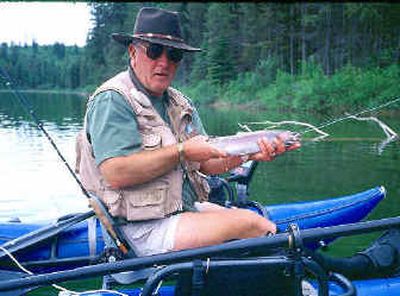Anglers see transition in strength of B.C. fisheries

A new era is developing for fishermen who have made traditions of catching trout in British Columbia’s southeastern waters. New attractive fisheries are emerging while the fishing quality is fading at some perennial favorite lakes.
For example, Whitetail Lake, a popular destination for American fly fishers, no longer produces large numbers of 25- to 30-inch rainbows. Nearly all of the Gerard strain rainbows are 20- to 22-inchers at the lake west of Canal Flats.
That’s still good, but a definite decline in the opinion of anglers who have been there for the good ol’ days.
Whiteswan Lake, southeast of Canal Flats, produces more and bigger bragging-size trout than Whitetail, according to Kelly Laatsch, operator of the St. Mary Fly Shop at Kimberley. Several other lakes, now under highly restrictive regulations, hold trout bigger than Whitetail’s fish, said Laatsch, one of the best-known fishing guides in the East Kootenay region.
Nine Bay Lake, west of Parsons, has big numbers of outsized trout and could be producing triploid rainbows weighing more than 10 pounds in a year or so, Laatsch said during a recent program for the Inland Empire Fly Fishing Club.
Several lakes will benefit from the restrictive regulations that became effective April 1, Laatsch said. The rules are the same as those for Whitetail: daily limit of one, none under 50 cm (about 20 inches), bait ban, single hook.
Speaking of Whitetail, he said “It’s a nice lake to fish, but it’s overused.”
The average size of the Whitetail rainbows has dropped dramatically the last few years as the result of the near-disappearance of big weed beds. Nevertheless, scores of fly fishers likely will camp at the lake in June. For many, the trip to Whitetail has become a social tradition as well as a fishing occasion.
Although damselflies no longer hatch in large numbers at Whitetail, the lake still has big hatches of caddisflies, including the so-called traveling sedges.
Laatsch said fly fishers should consider fishing Whiteswan Lake, “an exceptionally productive lake that holds big trout, has excellent provincial campgrounds and hot springs where anglers can take hot showers anytime.”
Rainbows measuring 26 inches and longer are not uncommon at Whiteswan, he said. Fly fishers use chironomid pupa, damselfly and leech patterns starting in late May and in June.
Near-by Alces, a fly-fishing-only lake, produces excellent fishing for big rainbows. Many fly fishers camp at the big provincial campground at one end of the lake.
The roads to some of these restricted lakes are horrendous, but that doesn’t stop determined fly fishers.
The Nine Bay road is deeply rutted and can be almost impassable after rainstorms. Only four-wheel-drive vehicles are recommended.
However, Nine Bay, which has almost unbelievably large insect hatches, may become the destination of big-fish hunters the next few years. Laatsch said fisheries officials, aware that the insect biomass is ideal, are releasing triploid rainbows in the picturesque lake. Last year a rainbow weighing nearly 10 pounds was caught; most of the fish caught, though, were 22 to 26 inches long.
The triploid rainbows should grow fast in Nine Bay and anglers soon could be catching 5- to 10-pounders.
Wilbur Lake, only a few hundred yards from an excellent gravel road, almost certainly will benefit from the new restrictive regulations. It’s so accessible that British Columbia, Alberta and American fishermen have taken home unusually large numbers of the rainbows, effectively keeping the average size down to 14 to 18 inches. Under the new rule, anglers this year can kill only one rainbow 20 inches or longer. The average size likely will increase to more than 20 inches this year and larger in future years.
Wilbur has one of the most prolific sedge (caddis) hatches in British Columbia. When the sedges hatch, which starts the second week of June, every rainbow in the lake seems to cruise around to gobble up the big insects.
Little Mitten, a small lake that holds trout as long as an old gorilla’s arms, no longer is a hike-in lake, Laatsch said. With a new logging road offering vehicle access, the lake is likely to be crowded this year.
However, getting into McLean, a small lake where many trout are more than 25 inches long, continues to be a challenge. The road is primitive even by British Columbia standards.
Most anglers who fish Nine Bay, Little Mitten, Wilbur, McLean and other lakes in the area camp at the Mitten Lake campground, a huge area with tables and outhouses. Mitten, a put-and-take lake, is fished primarily by trollers and bait fishers.
Laatsch recommended that fly fishers consider fishing some of a group of lakes west of Brisco, among them Cleland and Cartwright.
Premier Lake, a good-sized lake south of Whiteswan, holds trout ranging 14-20 inches long, he said. They are so plentiful an experienced fisher can hook 20 or more a day. Fisheries officials encourage anglers to kill limits of the exceptionally tasty rainbows.
“There are many bays, so fishermen can get out of the wind,” he said. “The lake can be fished from any size boat, from a float tube to a big, high-powered boat.
“Fly fishers will see lots of double-anchored 14-foot boats. They’ll be fishing chironomid patterns.”
An excellent provincial campground is at one end of Premier Lake, which has two launch ramps, one at the campground and the other halfway down the lake operated by a rod and gun club.